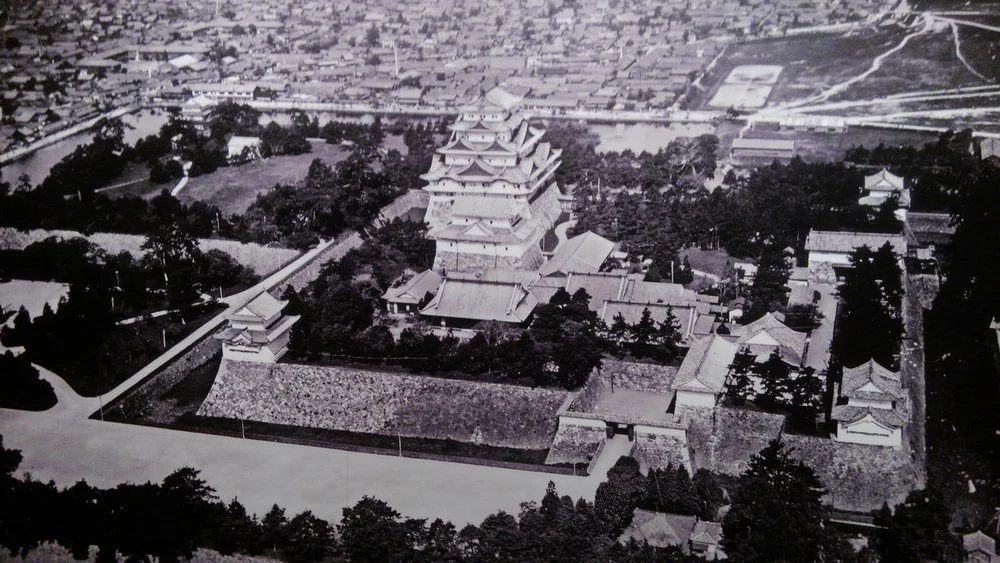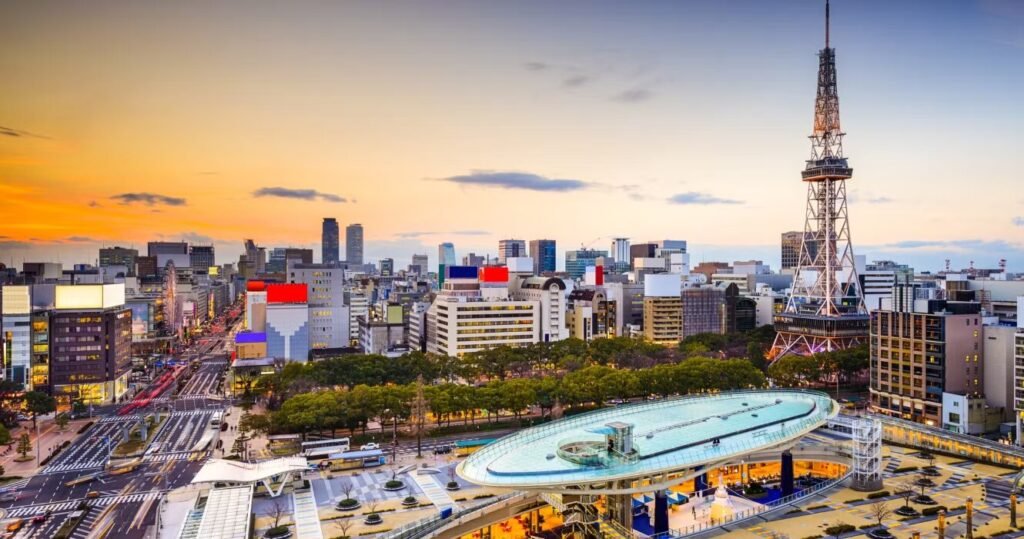Nagoya Then and Now
Nagoya Then
Nagoya, the capital of Aichi Prefecture in central Honshu, Japan, is one of the country’s foremost industrial hubs, strategically situated at the head of Ise Bay.
The city is often referred to by the name “Chūkyō,” meaning “middle capital” (from chū for “middle” and kyō for “capital”), which reflects its central location within Japan and its importance as a metropolitan and industrial center.
This name, Chūkyō, is widely used in regional references and industry, such as in the Chūkyō Industrial Area, a key zone for manufacturing and technological development, and the Chūkyō Metropolitan Area, which includes Nagoya and its surrounding urban regions.
This designation extends to local institutions and infrastructure, including Chūkyō Television Broadcasting, Chukyo University, and the Chukyo Racecourse, highlighting the city’s significant cultural and economic presence in Japan.

Nagoya History
Nagoya’s history is deep-rooted, beginning before its establishment as a city and extending through various significant historical periods in Japan.
Before Nagoya was officially settled, the area was already a site of ancient activity. During the Jomon and Yayoi periods, the Ōguruwa Shell Midden was discovered, marking early human settlement.
By the Kofun period, Nagoya saw the construction of notable burial mounds, such as the Danpusan and Shiratori Kofun.
The ancient Atsuta Shrine, one of Japan’s most revered Shinto shrines, was also established around this time, housing the legendary Kusanagi no Tsurugi, a sword from Japan’s Imperial Regalia.
Related Article: Osaka Then and Now
In the Heian period, the influential Fujiwara clan established Seigan-ji Temple, and it is believed that Yura-Gozen, a member of the Fujiwara family, married Minamoto no Yoshitomo.
Their son, Minamoto no Yoritomo, who was born in Nagoya, went on to found the Kamakura shogunate, solidifying the city’s historical importance.
In the Sengoku period, Nagoya emerged as a significant political center when Oda Nobunaga and his followers, including Toyotomi Hideyoshi and Tokugawa Ieyasu, rose to power and unified Japan.
In 1610, Tokugawa Ieyasu moved the capital of Owari Province to Nagoya, constructing Nagoya Castle and relocating residents from Kiyosu to the newly planned city, further establishing Nagoya’s strategic importance.
Related Article: Busan Then and Now
Nagoya’s role expanded during the Meiji Restoration (1868), a period of political and social upheaval in Japan that ended the rule of the shogunate and established a modern state.
Nagoya became a major industrial hub, known for its pottery, textiles, and mechanical craftsmanship.
Industries such as Mitsubishi Aircraft Company, founded in 1920, made Nagoya a center for aviation manufacturing, playing a critical role in Japan’s industrial growth and wartime production.
However, Nagoya was heavily bombed during World War II due to its role in the Japanese aircraft industry, with significant portions of the city destroyed, including Nagoya Castle.
Related Article: Taipei Then and Now

After the war, Nagoya rebuilt itself as one of Japan’s leading industrial and manufacturing centers, producing automobiles, machinery, and steel.
The city’s central location and advancements in infrastructure, including the port and Shinkansen railways, supported this rapid economic recovery.
By hosting major international events like Expo 2005 and the Nagoya Protocol conference in 2010, Nagoya strengthened its role in global industry and diplomacy.
Related Article: Ho Chi Minh City Then and Now
Nagoya’s cultural legacy remains vibrant, with institutions like Nagoya University and the Tokugawa Art Museum preserving its rich heritage.
Key landmarks, including the restored Nagoya Castle, Atsuta Shrine, and Higashiyama Park, continue to draw visitors.
Today, Nagoya blends its historical significance with a thriving modern industry, making it a vital cultural and economic center in Japan.
Related Article: Manila Then and Now
Nagoya Geography
Nagoya’s geographical location on the Nōbi Plain, north of Ise Bay, played a central role in its historical and economic development.
Built strategically on low-level plateaus, the city was designed to reduce the risk of flooding, a crucial consideration given the region’s fertile land and frequent rainfall.
This plan is among the most agriculturally productive areas in Japan, providing a solid foundation for local and regional trade.
Additionally, the natural waterways around Nagoya have been essential to its economy and transport networks.
Related Article: Jakarta Then and Now
The Kiso River, forming the western boundary of the city, and the Shōnai River, flowing from the northeast and curving southward at Nishi Ward, allowed for the transportation of goods and people from inland regions to the bay, fostering trade and economic interaction with neighboring areas.
A unique feature of Nagoya’s landscape is the Hori River, an artificial canal constructed in 1610 as part of the Shōnai River system.
Running north to south, it was designed to enhance connectivity within the city and link it to major waterways, improving trade efficiency.
The Tempaku River, which gathers water from smaller streams in the east, further enriches Nagoya’s waterway network.
Related Article: Guangzhou Then and Now
It flows southward before turning westward at Ōdaka, where it ultimately empties into Ise Bay.
These rivers collectively established a natural infrastructure that enabled Nagoya to thrive as a hub of commerce and communication.
Nagoya’s central location within Japan has also contributed to its political and economic significance.
Positioned between the nation’s two primary cultural and economic centers, Tokyo and Kyoto (later Osaka), Nagoya became a vital connector, facilitating the movement of goods, people, and ideas across Japan.
This advantageous placement, combined with its rich land and river systems, laid the groundwork for Nagoya’s growth as a powerful city with enduring influence in industry, trade, and culture.
Related Article: Shenzhen Then and Now
Nagoya Now

Nagoya stands as the largest city in Japan’s Chūbu region, serving as an economic and cultural powerhouse.
With a population of 2.3 million as of 2020, it is the fourth most populous city in the country.
It is the focal point of the Chūkyō metropolitan area, Japan’s third-largest metropolitan region, home to approximately 10.11 million people.
Related Article: Beijing Then and Now
This expansive metropolitan area is a critical part of Japan’s economic infrastructure, bridging eastern and western Japan and connecting urban and industrial centers across the country.
Situated along the Pacific coast in central Honshu, Nagoya is not only the capital of Aichi Prefecture but also its most densely populated city.
Its strategic coastal location grants it direct access to maritime trade routes, which has contributed significantly to its industrial and economic strength.
Related Article: Mumbai Then and Now
The Port of Nagoya, the largest seaport in Japan, plays a pivotal role in both the local and national economy, facilitating the import and export of a vast array of goods, from raw materials to high-tech products.
This port has long been a central artery for Japan’s trade, allowing Nagoya to maintain its position as a key player in the country’s heavy industries and manufacturing sectors.
Nagoya’s size and importance within the Chūbu region and broader national context make it a leading center for business, innovation, and culture in Japan.
Related Article: Kuala Lumpur Then and Now
Its high population density and strategic location help sustain its role as a central hub in Japan’s transportation network, linking it with other major cities and regions.
This connectivity, combined with its economic vitality, has enabled Nagoya to become a vibrant city with a rich history and a promising future as a central pillar in Japan’s industrial landscape.
Related Article: Bangkok Then and Now
FAQs
Nagoya is famous for its rich history, being a center of Japan’s automotive industry (home to Toyota), and historical sites like Nagoya Castle and Atsuta Shrine.
The city is also renowned for its contributions to technology, ceramics, and as a significant industrial hub.
Nagoya is popular for its cuisine (including hitsumabushi, miso katsu, and tebasaki), impressive museums like the Toyota Commemorative Museum of Industry and Technology, vibrant festivals, and its proximity to beautiful destinations like the Nakasendo Trail and Ise Shrine.






























